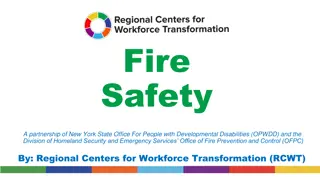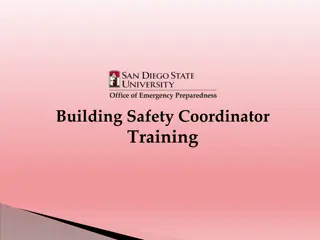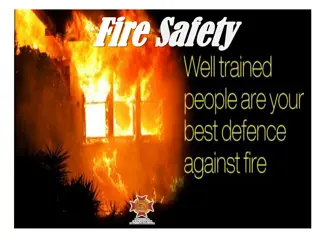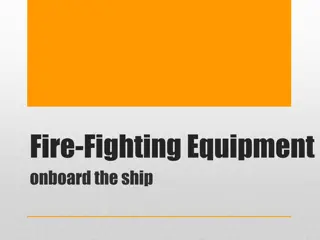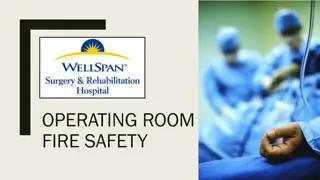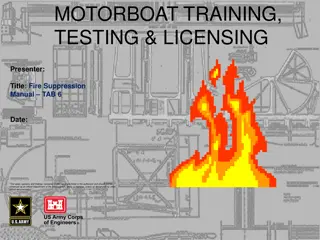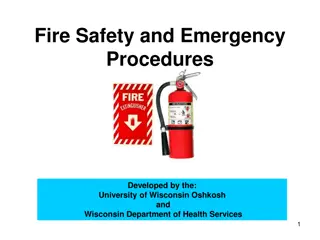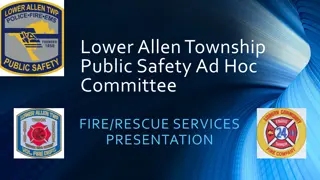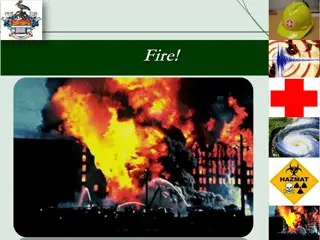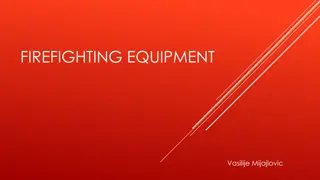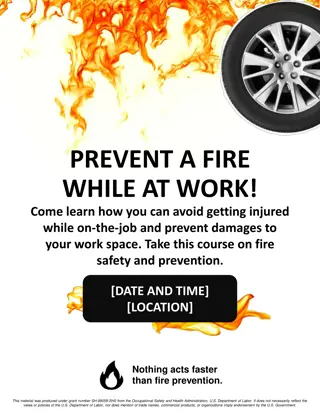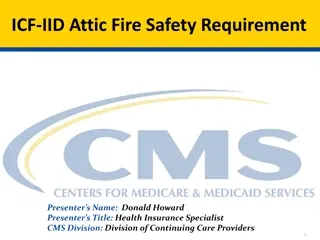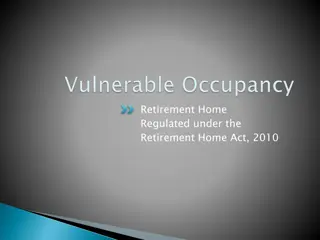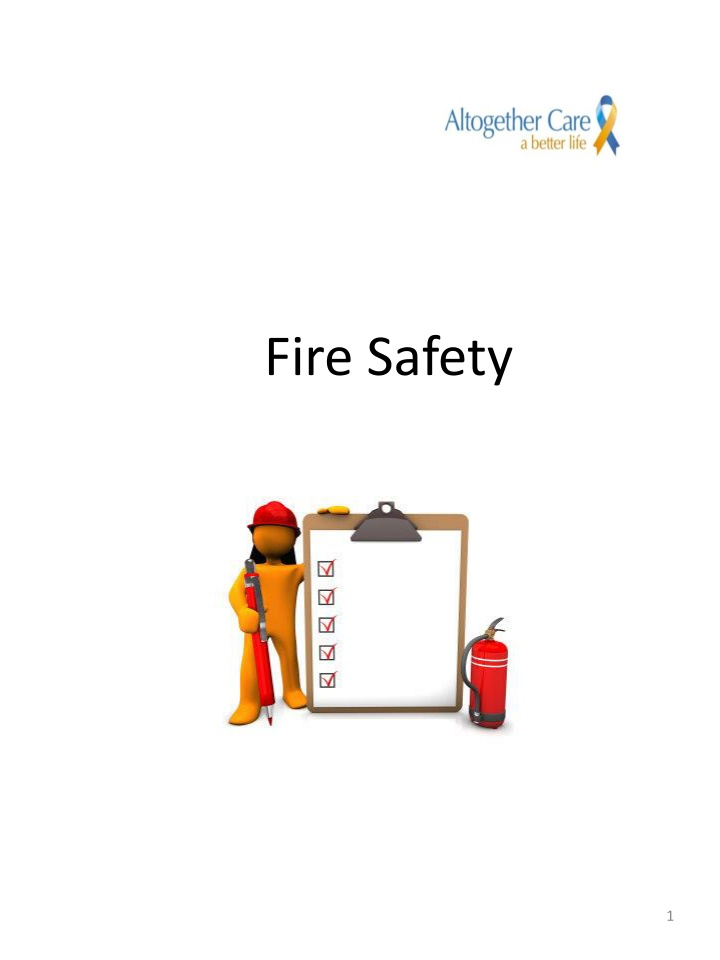
Fire Safety Measures for Workplace and Home
Learn about fire safety principles, risks, prevention, and emergency evacuation strategies. Discover why fires are dangerous and how to protect against them. Find out about the legislation, employer responsibilities, and employee duties related to fire safety. Explore tips on reducing fire hazards and ensuring a safe environment. Be prepared with knowledge on fire detection systems, emergency lighting, and the importance of clear escape routes.
Download Presentation

Please find below an Image/Link to download the presentation.
The content on the website is provided AS IS for your information and personal use only. It may not be sold, licensed, or shared on other websites without obtaining consent from the author. If you encounter any issues during the download, it is possible that the publisher has removed the file from their server.
You are allowed to download the files provided on this website for personal or commercial use, subject to the condition that they are used lawfully. All files are the property of their respective owners.
The content on the website is provided AS IS for your information and personal use only. It may not be sold, licensed, or shared on other websites without obtaining consent from the author.
E N D
Presentation Transcript
Fire Safety Fire Safety 1
What is a fire? Fire is a chemical reaction in which heat and light are evolved. For combustion to occur three things are required: Oxygen, heat and fuel. Fire fighting revolves around the principle that removing one or more of these elements will extinguish a fire. We can eliminate by: starving it of fuel smothering it to exclude oxygen cooling it to reduce temperature Fire Fact: A fire can fully engulf a room in three minutes and reach temperatures 1100 C. You cannot do a lot in 3 minutes. You must NEVER put yourself in danger. Legislation Regulatory Reform (fire safety) Order 2005 Employers must carry out risk assessments. They must ensure that adequate and appropriate fire safety measures are implemented to minimise the risk of injury or loss of life in a fire. Fire/smoke detectors must be installed to give adequate warning of a fire, install the correct fire fighting equipment Staff should be trained in risk assessment, and fire drills. Fire risk assessments should be reviewed regularly. To prevent fire in the workplace staff must identify and report any fire risks. Employee responsibilities: Ensure good housekeeping to avoid build up of combustible material. Attend regular update training and drills Keep fire exits clearly marked and accessible Cooperate with your employer to ensure your workplace is safe Do not do anything which will place yourself or other people at risk 2
Why are fires dangerous? When a fire occurs in a building it is a threat because: Toxic fumes: are given off as various materials burn, especially foam and plastic. These fumes can be deadly. Smoke: given off from the fire can also be poisonous, but smoke causes choking, reducing vision and can lead to panic. Burning: heat is produced from any fire and can cause serious damage not just to from skin burns but also by inhalation where lungs can be damaged. Structural damage: building structures can be weakened by fire and therefore there is a risk of collapse. Most common fire hazards: Careless storage of flammable or combustible materials Accumulation of rubbish Inadequate cleaning of work areas and poorly maintained equipment Electrical circuits overloaded or in poor condition Unauthorised repairs or modifications to electrical equipment Electrical equipment left on when not in use Careless use of mobile heaters Obstructing ventilation of heaters and other appliances Smoking in unauthorised areas and careless disposal of smoking materials. Fire Prevention Reduce possibility of fire by managing the main fire hazards i.e. Flammable & combustible materials Work process involving heat Electrical equipment and heaters Smoking Building & maintenance work Combustible waste Arson 3
In addition to basic fire precautions, quick & safe evacuation can be achieved by: Good housekeeping Escape routes being kept clear Security to reduce arson Regular fire safety checks By the way this is NOT an example of a clear escape route Fire Safety signs Under the Health and Safety (Safety Signs and Signals) Regulations 1996, sign colours have specific meanings: RED used for identification and location of all fire-fighting equipment GREEN is used to indicate all doors, exits and routes on emergency escape routes A directional arrow may be Incorporated into the sign but cannot be used by itself Generally, all emergency exits and exits not in normal use should be clearly indicated to that everyone is aware that there are ways to leave the building other than the doors which they used to gain admission Emergency Lighting Emergency lighting fulfils the following functions: Clearly indicates the escape routes Provides illumination along such routes Ensures that fire alarm points and fire fighting equipment provided along such routes can be located. Fire detection systems Fire detection systems can perform a number of functions: Provide an early warning of fire Provide control signals to automatic protection equipment installed such as Smoke vents Door release systems Fixed fire fighting systems Equipment to alert the fire services 4
Classification of fuels Not all fuels are the same, and if you use the wrong type of fire extinguisher on the wrong type of fuel, you can, in fact, make matters worse. It is therefore very important to understand the four different classifications of fuel. Class A - wood, paper, cloth, plastic. Class B - flammable liquids: petrol, kerosene, oil, fats, grease, acetone, paint. Class C - flammable gasses: LPG, butane, acetylene, and hydrogen. Class D - metals: potassium, sodium, aluminium, magnesium. Types of fire extinguisher The contents are indicated by a colour zone on the body of the extinguisher. Use and colour coding to BS EN : 1996 It's easy to remember how to use a fire extinguisher if you can remember the acronym PASS which stands for Pull - Pull the pin out Aim - At the base of the fire Squeeze the two handles together Sweep the hose from side to side A fire extinguisher will only last a few minutes. Once it is empty, remove yourself taking the extinguisher with you. 5
Fire Blankets Fire blankets are used to cover small fires to exclude the oxygen, they come in a self contained sleeve. Used on oil and fat fires or to wrap around a casualty. Use on 'Class A, B & D' General instructions for use: Read instruction plate before use Ensure that you are positioned between the fire and a safe exit or escape route Hold blanket by the tapes and gently cover burning material completely, using the blanket to shield your face. Switch off electricity or gas supply and leave the area closing all doors behind you. Leave to cool for at least 30 minutes, keeping out of the smoke When not to fight a fire: Fire Extinguishers are designed to fight small, developing fires. If a fire starts to burn out of control, it is not safe to try and extinguish it yourself. NEVER try to fight a fire if: The fire is no longer contained and starts spreading beyond where it started. You can't fight the fire with your back towards an open escape route. the fire could spread and block your only escape route. You don t have the right fire extinguisher. You don t know how to use a fire extinguisher In any of these situations CALL FOR HELP DON T FIGHT THE FIRE YOURSELF In domiciliary care remember : You may not have any fire fighting equipment at all. There may not be any emergency lighting There may not be any emergency exit signs The only fire equipment may be a smoke detector. 6
Action to take in the event of a fire: Shout FIRE Call the fire service If safe to do so, tackle the fire, if in doubt get out. If the client is mobile, assist outside. If the client is not mobile, leave the client inside, close all windows and internal doors, get out and await the arrival of the fire service. You are then able to inform the fire service of the whereabouts of the fire and the client, as well as the client s mobility limitations DO NOT re-enter the building once you have exited. Contact on-call or the office once it is safe to do so. 7

